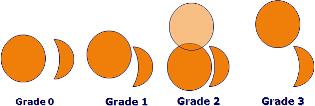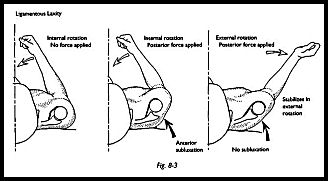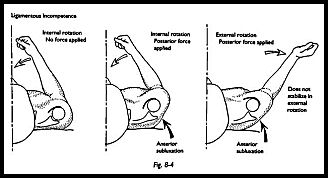Examination Under Anaesthesia
Technique for Examination of the Shoulder Prior to Instability Surgery:
The examination under anaesthesia (EUA) is an essential part of the assessment of any patient prior to undergoing shoulder surgery. The aims of an EUA depends on the clinical presentation but are essentially twofold:
- Confirmation of passive range of motion (if this was noted to be abnormal)
- Assessment of abnormal shoulder translation
Neither of these can be easily achieved without comparison to the asymptomatic side, and hence no EUA is complete without examination of both shoulders. The EUA is usually performed once the patient is position in the beach chair position prior to the application of traction. The EUA can however be performed with the patient supine prior to positioning.
Procedure:
It is important to have a systematic approach to the EUA of an unstable shoulder. By the examination in turn of anatomical structures one is able to confirm the degree and the symptomatic direction of abnormal laxity, as well as any associated significant bony defects. This is crucial in the planning of surgical treatment. This is essentially a modification of Cofield's technique.
Laxity is graded on a scale of 0 to 3, based on humeral head translation in relation to the glenoid:
| 0 | No movement |
| 1 | Movement to the edge of the glenoid rim |
| 2 | Off the end of the glenoid and reduces spontaneously |
| 3 | Off the end of the glenoid, but does not reduce spontaneously |

1. Anterior and Posterior capsule:
Standing behind the patient one hand is placed on the shoulder with index and thumb over the humeral head, while the other hand holds the forearm providing rotational control. An anterior draw test is then performed with the arm in internal rotation and 20 degrees of abduction, and graded 0-3. The anterior capsule is then tensioned by externally rotating the arm in the same degree of abduction. Should the anterior structures prove to be competent, then the degree of anterior translation will be decreased or obliterated.
The same manoeuvre is then performed in reverse for assessment of posterior instability with the arm initially tested in external rotation and then in internal rotation to tension posterior structures.


from Copeland: Shoulder Surgery
2. Inferior capsule and rotator interval:
A sulcus sign can be elicited through the inferior (caudal) traction of the Humerus with one hand while stabilising the scapula with the other. The degree of inferior translation is then graded 0-3, as above.
Rotator interval competency can be tested by then performing the same manoeuvre in external rotation. A competent rotator interval should reduce the amount of caudal translation in external rotation compared to internal rotation.
Inferior laxity can be confirmed with Gagey's sign : the scapula is stabilised with one hand and the arm is abducted with the other. Achieving abduction beyond 105 degrees is regarded as abnormal but should be compared to the contra lateral side as previously mentioned.
3. Bony defects:
Assessment of the extent in particular of a Hill Sachs lesion is an important part of an EUA. Engagement of a bony lesion with the arm in 45deg of abduction and external rotation is indicative of a large lesion as describe by Bushnell et al .
Steps of EUA:
1. Anterior laxity - neutral and external rotation
2. Posterior laxity - neutral and internal rotation
3. Rotator Interval - sulcus in neutral and external rotation
4. Inferior capsule - Gagey's test
5. Large bony lesions - position of engagement
References:
- Cofield RH, Irving JF, Evaluation and classification of shoulder instability, with special reference to examination under anaesthesia, Clin Orthop (1987) Oct(223):32-43
- Gagey O and Gagey N. The hyperabduction test: AN ASSESSMENT OF THE LAXITY OF THE INFERIOR GLENOHUMERAL LIGAMENT. J Bone Joint Surg Br, Jan 2001; 83-B: 69 - 74.
- Bushnell et al. The Bony Apprehension Test for Instability of the Shoulder: A Prospective Pilot Analysis. Arthroscopy. 24(9): 974-982. Sept 2008


